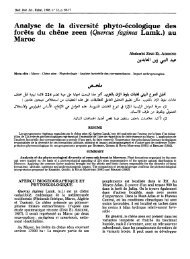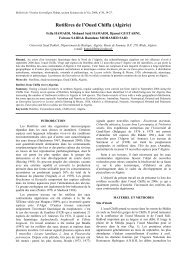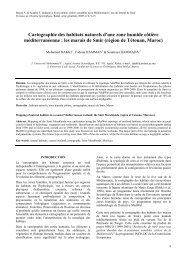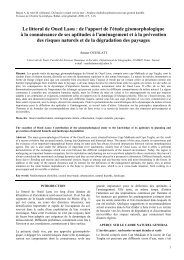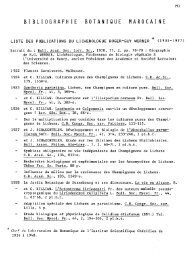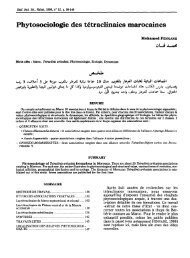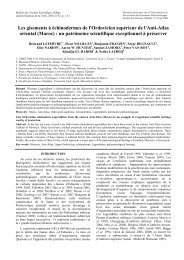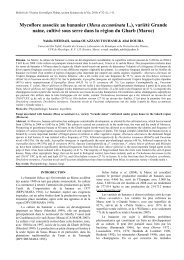The Emsian to Eifelian near Foum Zguid (NE Dra Valley, Morocco)
The Emsian to Eifelian near Foum Zguid (NE Dra Valley, Morocco)
The Emsian to Eifelian near Foum Zguid (NE Dra Valley, Morocco)
Create successful ePaper yourself
Turn your PDF publications into a flip-book with our unique Google optimized e-Paper software.
Devonian of the western Anti Atlas : correlations and events. Doc. Inst. Sci, Rabat, 19, 2004, 19-28 19<br />
<strong>The</strong> <strong>Emsian</strong> <strong>to</strong> <strong>Eifelian</strong> <strong>near</strong> <strong>Foum</strong> <strong>Zguid</strong> (<strong>NE</strong> <strong>Dra</strong> <strong>Valley</strong>, <strong>Morocco</strong>)<br />
Ulrich JANSEN, Gerhard BECKER, Gerhard PLODOWSKI, Eberhard SCHINDLER,<br />
Olaf VOGEL & Karsten WEDDIGE<br />
Forschungsinstitut Senckenberg, Senckenberganlage 25, D-60325 Frankfurt am Main, Germany, Ulrich.Jansen@Senckenberg.de<br />
LOCATION AND INTRODUCTION<br />
<strong>The</strong> development of the Lower Devonian in the <strong>NE</strong> <strong>Dra</strong><br />
<strong>Valley</strong> is completely different from that of the SW <strong>Dra</strong><br />
<strong>Valley</strong> (see BECKER et al., this volume). A conspicuous<br />
character is the very thick development of the <strong>Emsian</strong><br />
Mdâouer-el-Kbîr Formation (“Rich 3”) whose timeequivalents<br />
in the SW <strong>Dra</strong> <strong>Valley</strong> are the Oui-n-Mesdoûr<br />
and basal Khebchia formations.<br />
<strong>The</strong> Mdâouer-el-Kbîr Formation (= most of the former<br />
“Rich d’El Annsar” or “Rich 3” sensu HOLLARD 1963,<br />
1965, 1967) is typically developed in the <strong>NE</strong> <strong>Dra</strong> Plains<br />
between Akka and <strong>Foum</strong> <strong>Zguid</strong>. <strong>The</strong> strata included in the<br />
Mdâouer-el-Kbîr Formation were dated as Late <strong>Emsian</strong><br />
(HOLLARD 1963, 1965, 1967, 1981a) or as Early <strong>to</strong> Late<br />
<strong>Emsian</strong> (HOLLARD 1978, 1981b, BULTYNCK & HOLLARD<br />
1980, JANSEN 2000, 2001).<br />
<strong>The</strong> Mdâouer-el-Kbîr Formation reaches a <strong>to</strong>tal thickness of<br />
almost 300 m SW of <strong>Foum</strong> <strong>Zguid</strong>. <strong>The</strong> section <strong>Foum</strong> <strong>Zguid</strong><br />
(Fig. 1, 2), described by JANSEN (2001), gives a good<br />
impression of this formation and the overlying<br />
Timrhanrhart Formation. Unfortunately, the base of the<br />
Mdâouer-el-Kbîr Formation with its basal limes<strong>to</strong>ne is not<br />
exposed. According <strong>to</strong> our biostratigraphic results, the<br />
section starts <strong>near</strong> the Lower/Upper <strong>Emsian</strong> boundary and<br />
reaches up well in<strong>to</strong> the <strong>Eifelian</strong>. <strong>The</strong> first boundary can<br />
only be drawn with some vagueness by brachiopod-based<br />
correlations within the Rich 3 sands<strong>to</strong>nes, whereas the<br />
<strong>Emsian</strong>/<strong>Eifelian</strong> boundary can be reproduced quite exactly<br />
by different groups of fossils (dacryoconarid tentaculitids,<br />
goniatites, trilobites, ostracods, conodonts) within the<br />
Timrhanrhart Formation. Lithostratigraphical units within<br />
the Timrhanrhart Formation as defined by BECKER et al.<br />
(this volume) could not yet be considered. Calibration with<br />
the type section has <strong>to</strong> be provided later.<br />
<strong>The</strong> section is situated <strong>near</strong> the main road from Agadir<br />
Tissint <strong>to</strong> <strong>Foum</strong> <strong>Zguid</strong>, 25 km SW of <strong>Foum</strong> <strong>Zguid</strong> in the<br />
<strong>NE</strong> <strong>Dra</strong> <strong>Valley</strong> (Fig. 1). Coming from Agadir Tissint, 1 km<br />
after passing the sign “<strong>Foum</strong> <strong>Zguid</strong> 25 km”, the road<br />
crosses a small “oued” (wadi). After passing the S<br />
termination of the NW situated ridge the section is located<br />
approximately 2 km NW of the road on <strong>to</strong>p of the ridge.<br />
GPS coordinates at Unit 1 are N 29° 55,796’ W 07°<br />
02,873’. <strong>The</strong> dip of the strata is 20° <strong>to</strong> 28° <strong>to</strong>wards the<br />
SSW.<br />
SEDIMENTARY AND FAUNAL SUCCESSION<br />
Units –6 <strong>to</strong> 0: Rich 3 Sands<strong>to</strong>ne Beds, upper part of the<br />
Mdâouer-el-Kbîr Formation. Thick succession of<br />
sands<strong>to</strong>nes and silts<strong>to</strong>nes at the eastern slope of the hill.<br />
Unit –6 forms a small, isolated ridge running along the base<br />
of the hill. It is built up by several decametres of thickbedded,<br />
quartzitic sands<strong>to</strong>nes. Its <strong>to</strong>tal thickness is<br />
unknown. Shelly fossils have not been found in these<br />
sands<strong>to</strong>nes. Above the sands<strong>to</strong>nes there is a covered<br />
interval measuring about 60 m thickness. <strong>The</strong> succession<br />
from Units –5 <strong>to</strong> 0 has a thickness of 110 m. It is composed<br />
of alternating silty shales, silts<strong>to</strong>nes and sometimes nodular<br />
sands<strong>to</strong>nes. At the <strong>to</strong>p of Unit –3, 40 m below Unit 1, thick<br />
sands<strong>to</strong>ne beds occur reaching up <strong>to</strong> 1 m. <strong>The</strong> first shelly<br />
fauna composed of strophomenid and spiriferid<br />
brachiopods occurs in Unit –2 (see chapter 4). Massive and<br />
thick-bedded sands<strong>to</strong>nes of Unit 0 form the edge of the hill,<br />
where the more evenly exposed continuation of the section<br />
begins.<br />
<strong>The</strong> facies of the described succession reflects an aquatic<br />
environment with more or less strong currents and<br />
siliciclastic sediment transport. <strong>The</strong> lower sands<strong>to</strong>nes which<br />
are devoid of marine fossils could have been deposited in a<br />
<strong>near</strong>-shore, hostile environment. <strong>The</strong> facies of the fossilbearing<br />
succession may be called “Rhenish” reflecting a<br />
shallow-marine environment of the neritic zone.<br />
Units 1 <strong>to</strong> 15g: Rich 3 Sands<strong>to</strong>ne Beds (continued), upper<br />
part of Mdâouer-el-Kbîr Formation. With Unit 1, the proper<br />
section starts. <strong>The</strong> 112 m thick succession consists of<br />
sands<strong>to</strong>nes and silts<strong>to</strong>nes forming an up and down of small<br />
ridges and depressions, producing a stepwise slope rising<br />
<strong>to</strong>wards the SSW. <strong>The</strong> entire section reveals a cyclic pattern<br />
including silts<strong>to</strong>nes or silty sands<strong>to</strong>ne intervals separated by<br />
sands<strong>to</strong>ne beds.<br />
Unit 1 is represented by a 1.4 m sandy silts<strong>to</strong>ne followed by<br />
1.2 m sands<strong>to</strong>ne beds of Unit 2 which are characterized by<br />
mass occurrences of large Euryspirifer cf. pellicoi (DE<br />
VER<strong>NE</strong>UIL & D’ARCHIAC 1845) and the chonetid Loreleiella<br />
(brachiopod faunas are discussed in chapter 4),<br />
accompanied by large bivalves. For the shells are<br />
distributed irregularly within the beds, they may be<br />
interpreted as tempestites – as well as many others in the<br />
Rich 3 Sands<strong>to</strong>ne Beds.<br />
Further up, 11.3 m sandy silts<strong>to</strong>ne layers of Units 3 and 4<br />
are present, with intercalations of up <strong>to</strong> 10 cm thick<br />
sands<strong>to</strong>ne beds, where homanolotid trilobites have been<br />
found. <strong>The</strong> 1.9 m thick Unit 5, built up by sands<strong>to</strong>ne beds,<br />
bears many large bivalves (“Pterinea”), tentaculitids s.str.<br />
and a diverse brachiopod fauna which is concentrated in<br />
three beds. Besides Euryspirifer cf. pellicoi (DE VER<strong>NE</strong>UIL<br />
& D’ARCHIAC 1845), which again is very abundant, other<br />
spiriferids and strophomenids are present. After careful<br />
examination of the fauna by comparisons with western and<br />
central European forms (JANSEN 2001), a position close <strong>to</strong><br />
the boundary Lower/Upper <strong>Emsian</strong> as defined in the<br />
Ardenno-Rhenish Mountains (SOLLE 1972) is evident,
20 JANSEN, U. & al.<br />
uppermost Lower <strong>Emsian</strong> seeming more probable than<br />
lowermost Upper <strong>Emsian</strong>. Unit 6 consists of 3.5 m silty und<br />
uneven sands<strong>to</strong>ne beds with a brachiopod shell bed at the<br />
<strong>to</strong>p.<br />
<strong>The</strong> next 49 m, sands<strong>to</strong>nes, silts<strong>to</strong>nes, marly silts<strong>to</strong>nes, and<br />
brachiopod shell beds of Units 7 <strong>to</strong> 15d, are extremely rich<br />
in fossils, mainly brachiopods of “Rhenish” aspect<br />
(strophomenids, orthids, spiriferids, terebratulids,<br />
rhynchonellids, athyridids, atrypids, inarticulates; see<br />
chapter 4), bivalves (e.g., ? Grammysioidea), trilobites<br />
(homalonotids), gastropods (e.g., large Platyceras), and<br />
some orthocone nautiloids. For orientation, Unit 9 is<br />
helpful, because its conspicuous iron-incrusted bedding<br />
surfaces, which are covered with fossils, are widely<br />
exposed and followed by a steep slope formed by Units 10<br />
<strong>to</strong> 12. <strong>The</strong> upper bedding surface of Unit 9 shows shells of<br />
the terebratulid Meganteris archiaci in living position. Unit<br />
10 has yielded brachiopods and the trilobites<br />
Parahomalonotus and Treveropyge.<br />
Fig. 1 - Location map of sections in the vicinity of Agadir Tissint<br />
(i.e., <strong>Foum</strong> <strong>Zguid</strong> I-III – the section <strong>Foum</strong> <strong>Zguid</strong> III is described in detail).<br />
Unit 14 is represented by a 21.0 m thick succession of silty,<br />
partly marly sands<strong>to</strong>nes including four harder and more<br />
prominent, calcareous beds being extremely rich in fossils<br />
(predominantly brachiopods): at 0.9 m (14 a), 4.5 m (14 b),<br />
11.3 m (14 c) and 18.6 m (14 d). <strong>The</strong> finer grained parts in<br />
between contain fossils as well. Other fossils than<br />
brachiopods are big gastropods (Platyceras), phacopids,<br />
and bivalves (e.g., Cornellites).<br />
Units 15a <strong>to</strong> 15d, the following 43.6 m of the section,<br />
consist of sandy silts<strong>to</strong>nes with three marked calcareous<br />
sands<strong>to</strong>ne beds. <strong>The</strong>ir brachiopods mainly belong <strong>to</strong> the<br />
spiriferids. Big Platyceras and orthocone nautiloids are<br />
present in Unit 15b. Units 15e-g (11.4 m thick) consist of<br />
brachiopod-bearing, often nodular sands<strong>to</strong>nes, silts<strong>to</strong>nes,<br />
and nodular marly limes<strong>to</strong>nes at the <strong>to</strong>p (15g). <strong>The</strong> section<br />
continues 80 m <strong>to</strong> the West from the Unit 15e level onward.<br />
Judging from the brachiopods, the position of this<br />
succession is still around the boundary interval<br />
Lower/Upper <strong>Emsian</strong>. Due <strong>to</strong> the fauna from Unit 9<br />
onwards, a position in the lower part of the Upper <strong>Emsian</strong><br />
seems more probable than in the upper Lower <strong>Emsian</strong>.<br />
Units 14b and 15a-d certainly belong <strong>to</strong> the lower Upper<br />
<strong>Emsian</strong>. In Unit 14b two fragmentary specimens of<br />
Mimagoniatites fecundus (BARRANDE 1865) (det. O.H.<br />
WALLISER) have been discovered corroborating the position<br />
in the Lower/Upper <strong>Emsian</strong> respectively<br />
Zlichovian/Dalejian boundary interval.<br />
<strong>The</strong> fauna from Unit 7 up <strong>to</strong> Unit 15 is characterized by a<br />
higher species diversity than the units below. In addition,<br />
orthocone nautiloids and goniatites are present showing an<br />
open-marine influence. It may be speculated that this faunal<br />
development in combination with the increase in calcareous<br />
and marly sediments is a result of a rising sea-level, which<br />
in turn could correspond <strong>to</strong> the transgressive Daleje Event<br />
(sensu CHLUPÁČ & KUKAL 1988).<br />
Summarizing Units 1 <strong>to</strong> 15g: <strong>The</strong>se units are developed in<br />
“Rhenish” facies reflecting a shallow-marine environment<br />
with high turbulence, turbid water, and siliciclastic<br />
sedimentation (cf. ERBEN 1962, CARLS et al. 1993). Many<br />
of the shell beds are considered as being of tempestitic<br />
origin. <strong>The</strong> great thickness in contrast <strong>to</strong> the relatively short<br />
time represented by these sedimentary rocks indicates<br />
considerable subsidence equalized by high rates of<br />
sedimentation.<br />
Units 15h <strong>to</strong> 15i: Timrhanrhart Formation, lower part<br />
(starting within Unit 15h). <strong>The</strong> section continues 50 m <strong>to</strong><br />
the West. <strong>The</strong> base of Unit 15h consists of 30 cm silts<strong>to</strong>nes,<br />
followed by a 70 cm thick sands<strong>to</strong>ne bed that is calcareous
<strong>Emsian</strong> <strong>to</strong> <strong>Eifelian</strong> <strong>near</strong> <strong>Foum</strong> <strong>Zguid</strong> 21<br />
at the base and gets more and more sandy <strong>to</strong>wards the <strong>to</strong>p.<br />
40 cm limes<strong>to</strong>ne beds follow. On <strong>to</strong>p of these, 20 cm<br />
muddy silts<strong>to</strong>nes and one 40 cm thick limes<strong>to</strong>ne bed are<br />
developed (fine-grained and dark); finally, three hard and<br />
nodular limes<strong>to</strong>ne beds, dark grey <strong>to</strong> dark blue-grey,<br />
measuring 50 cm in <strong>to</strong>tal are present.<br />
Fig. 2 - <strong>The</strong> section <strong>Foum</strong> <strong>Zguid</strong> (= <strong>Foum</strong> <strong>Zguid</strong> III in Fig. 1). Only distinct<br />
beds due <strong>to</strong> their fossil abundances and/or importance are indicated by<br />
symbols (especially in the lower part of the section, from Unit 2 onward<br />
brachiopods are very abundant and occur in almost each bed). Details are<br />
given in the text – the upper part is figured separately as Fig. 3.<br />
Unit 15i, reaching a thickness of 2.8 m, begins with 40 cm<br />
marls<strong>to</strong>nes containing calcareous nodules with trilobites,<br />
followed by a marly limes<strong>to</strong>ne bed yielding dispersed ooids<br />
of different form and size. This limes<strong>to</strong>ne contains<br />
trilobites, brachiopods, and crinoid columnals. 20 cm marly<br />
silts<strong>to</strong>nes and 1.9 m partly nodular limes<strong>to</strong>ne beds are<br />
developed at the <strong>to</strong>p of Unit 15i. Unit 15i contains the<br />
trilobite genera Phacops and Hollardops (det.<br />
G. SCHRAUT), orthocone nautiloids, corals, and a goniatite<br />
layer with Sellanarcestes. Stratigraphically, the unit clearly<br />
is Upper <strong>Emsian</strong>, the Sellanarcestes layer is situated in the<br />
serotinus Zone.<br />
Concerning the palaeoenvironment, a transgressive<br />
tendency can be stated, with a change from neritic <strong>to</strong> rather<br />
hemipelagic conditions.<br />
Units 16 <strong>to</strong> 17: Timrhanrhart Formation (upper<br />
parts), succession forming a steep slope.<br />
Unit 16 (34.4 m) starts with nodular limes<strong>to</strong>ne beds<br />
in the lower part, the nodules become increasingly<br />
marly upwards. <strong>The</strong>re are marls<strong>to</strong>ne layers between<br />
the nodules, grading in<strong>to</strong> greenish shales. 14 m<br />
above the base, the nodules become more frequent<br />
and grade in<strong>to</strong> limes<strong>to</strong>ne beds which are about 10<br />
cm thick. In the upper part of Unit 16, limes<strong>to</strong>ne<br />
beds and shales alternate. In the nodular layers and<br />
limes<strong>to</strong>ne beds (Units 16a-16o) conodont samples<br />
have been taken. <strong>The</strong> succession contains many<br />
ostracods, trilobites, dacryoconarid tentaculites,<br />
small brachiopods, solitary corals, crinoid<br />
columnals, cyr<strong>to</strong>ceratid nautiloids, and a few<br />
goniatites.<br />
<strong>The</strong> ostracod fauna is highly diverse (see Chapter 6)<br />
including, e.g., the genera Parabolbina, Ulrichia,<br />
Aechmina, Berdanella, Healdia, Polyzygia,<br />
Thlipsurella, Bufina, Praepilatina, Zeuschnerina,<br />
Bairdia, Acanthoscapha, Tricornina, and others,<br />
forms of E-Thuringian provenience. <strong>The</strong> faunal<br />
association shows close relationships <strong>to</strong> that of the<br />
uppermost <strong>Emsian</strong> <strong>to</strong> lowermost <strong>Eifelian</strong> Moniello<br />
and Polentinos formations in the Cantabrian<br />
Mountains. <strong>The</strong> overall aspect is <strong>Emsian</strong> until bed<br />
16k-3 proved by species of the genera above.<br />
Distinct Polyzygia species found in 16k samples<br />
agree with the <strong>Emsian</strong>/<strong>Eifelian</strong> boundary as<br />
indicated by other fossil groups (compare chapter<br />
3).<br />
Trilobites also include remarkably many genera,<br />
e.g., “Phacops”, Asteropyge, Thysanopeltis,<br />
Proetus, Cornuproetus, Otarion, Leonaspis,<br />
Parahomalonotus, Treveropyge, Walliserops<br />
(Plate 1, Fig. 9), and Koneprusia, especially in the<br />
Units 16b and 16m (16m = Thysanopeltis Bed).<br />
Some of the taxa are of biostratigraphic value with<br />
respect <strong>to</strong> the <strong>Emsian</strong>/<strong>Eifelian</strong> boundary (e.g.,<br />
Treveropyge, Parahomalonotus, and Thysanopeltis,<br />
for discussion see chapter 3).<br />
In some of the marls and limes<strong>to</strong>nes dacryoconarids<br />
are present. Besides styliolinids which do not<br />
indicate biostratigraphic information here, the nowakiids<br />
can be used for positioning of the <strong>Emsian</strong>/<strong>Eifelian</strong><br />
boundary by the occurrence of Nowakia (Dmitriella)<br />
sulcata sulcata (F.A. ROEMER 1843) and Nowakia<br />
(Maurerina) cf. procera (MAURER 1880) in bed 16k-1 (see<br />
chapter 3).<br />
Among the goniatites, taxa such as Fidelites cf. fidelis<br />
(BARRANDE 1865) [bed 16k-3], F. occultus (WHIDBOR<strong>NE</strong>
22 JANSEN, U. & al.<br />
1890) [bed 16l-5], and ? Foordites sp. are also indicating<br />
the lower <strong>Eifelian</strong> (det. R.T. BECKER).<br />
Conodonts could be obtained from some of the marls and<br />
marly limes<strong>to</strong>nes, even when they are very rare (see also<br />
chapter 3). Polygnathids, linguipolygnathids, and one<br />
icriodid taxon are present (compare chapter 6), with<br />
? Eucostapolygnathus costatus costatus (KLAPPER 1971)<br />
indicating the <strong>Eifelian</strong>.<br />
Fig. 3 - Upper part of the section <strong>Foum</strong> <strong>Zguid</strong> representing the<br />
Timrhanrhart Formation. Only remarkable beds are specially indicated;<br />
throughout this part of the outcrop, there are many ostracods, trilobites,<br />
crinoid ossicles and small brachiopods present. Dacryoconarids and<br />
goniatites occur in certain intervals; conodonts are very rare. Details are<br />
given in the text – units 16j <strong>to</strong> 16l are figured separately as Fig. 4.<br />
Unit 17 encompasses 11.6 m greenish shales with some<br />
layers of marls and calcareous nodules. In the upper part of<br />
the unit, sporadically limes<strong>to</strong>ne beds are intercalated<br />
reaching 30 cm thickness.<br />
<strong>The</strong> facies of Units 16 and 17 points <strong>to</strong> an open-marine,<br />
probably hemi-pelagic environment.<br />
<strong>The</strong> section is cut off by a doleritic dyke above Unit 17f.<br />
THE EMSIAN/EIFELIAN BOUNDARY<br />
<strong>The</strong> <strong>Foum</strong> <strong>Zguid</strong> section allows <strong>to</strong> pinpoint the<br />
<strong>Emsian</strong>/<strong>Eifelian</strong> boundary rather detailed in a<br />
continuous section based on more than a single<br />
fossil group (see Figs. 3-4). Conodonts,<br />
dacryoconarid tentaculites, goniatites, trilobites and<br />
ostracods can be considered for the boundary<br />
discussion. Although conodonts are very rare<br />
throughout the section due <strong>to</strong> the facial development<br />
the determination of <strong>Eifelian</strong> taxa is possible starting<br />
from within Unit 16k (? Eucostapolygnathus<br />
costatus costatus (KLAPPER 1971) in bed 16k-3).<br />
Among the trilobites which are extremely well<br />
preserved in the marly limes<strong>to</strong>nes ?Treveropyge sp.<br />
occurs up <strong>to</strong> bed 16j-1 and a parahomalonotid is<br />
present as high as bed 16k-1. Both forms are typical<br />
Lower Devonian ones, however, rare finds of<br />
parahomalonotids are also known from basal<br />
<strong>Eifelian</strong> strata (personal communication K.-W.<br />
WENNDORF, Braubach) and treveropygids may also<br />
occur in the basal <strong>Eifelian</strong> (for discussion see<br />
SCHRAUT 2000: 386). <strong>The</strong> first specimen of the<br />
<strong>Eifelian</strong> Thysanopeltis has been found in bed 16k-3.<br />
However, the lower boundary of the <strong>Eifelian</strong> stage<br />
may even be drawn slightly below this level due <strong>to</strong><br />
the occurrence of the dacryoconarids Nowakia<br />
(Dmitriella) sulcata sulcata (F.A. ROEMER 1843)<br />
and Nowakia (Maurerina) cf. procera (MAURER<br />
1880) in bed 16k-1. Due <strong>to</strong> the ostracods, the<br />
<strong>Emsian</strong>/<strong>Eifelian</strong> boundary interval is also indicated<br />
within levels 16k <strong>to</strong> 16l. Although the specimens of<br />
the genus Polyzygia resemble an <strong>Emsian</strong><br />
assemblage, especially Polyzygia antecedens<br />
ZAGORA 1968 is considered <strong>to</strong> extend in<strong>to</strong> the basal<br />
<strong>Eifelian</strong> (GARCÍA-ALCALDE et al. 2000). <strong>The</strong>refore,<br />
the occurrence of the taxon in bed 16k-1 is not<br />
puzzling even when these strata may already belong<br />
<strong>to</strong> the basal Middle Devonian. More information on<br />
the different faunal groups can be obtained from the<br />
following paragraphs.<br />
BRACHIOPODS (U.J.)<br />
<strong>The</strong> Rich 3 Sands<strong>to</strong>ne Beds contain diverse<br />
brachiopod faunas (Plate 1) which allow <strong>to</strong> draw<br />
biostratigraphic conclusions based on faunal<br />
comparisons with Western and Central Europe.
<strong>Emsian</strong> <strong>to</strong> <strong>Eifelian</strong> <strong>near</strong> <strong>Foum</strong> <strong>Zguid</strong> 23<br />
Fig. 4 - Detail of the <strong>Emsian</strong>/<strong>Eifelian</strong> boundary interval within the Timrhanrhart<br />
Formation (<strong>Foum</strong> <strong>Zguid</strong> section, units 16j <strong>to</strong> 16l) with important fossils for the<br />
boundary discussion. Details are given in the text.<br />
Brachiopods have been discovered from Unit –2 onwards.<br />
A general trend of increasing abundance and diversity is<br />
recognizable from bot<strong>to</strong>m <strong>to</strong> <strong>to</strong>p (excluding Units 15 <strong>to</strong> 17).<br />
In Units 2 and 5 mass occurrences of large Euryspirifer cf.<br />
pellicoi (DE VER<strong>NE</strong>UIL & D’ARCHIAC 1845) are present.<br />
Mainly Units 5, 7, and 9-15 contain highly diverse faunas<br />
including following taxa (partly preliminary<br />
identifications):<br />
“Discina” sp.<br />
lingulids<br />
Platyorthis circularis cf. circularis<br />
(SOWERBY 1842)<br />
Platyorthis nocheri (FUCHS 1915)<br />
Isorthis (Tyersella) tetragona (ROEMER<br />
1844)<br />
Schizophoria (Pachyschizophoria) tataensis<br />
JANSEN 2001 (one new subspecies)<br />
Leptaena sp.<br />
“Mclearnites” cf. cherguiensis JANSEN 2001<br />
Lep<strong>to</strong>strophiella cf. explanta (SOWERBY<br />
1842)<br />
“Boucotstrophia” jahnkei AIT MALEK,<br />
RACHEBOEUF & LAZREQ 1999<br />
Fascistropheodonta sp.<br />
Plicostropheodonta cf. virgata<br />
(DREVERMANN 1902)<br />
Pro<strong>to</strong>douvillina cf. taeniolata<br />
(SANDBERGER & SANDBERGER 1856)<br />
Stropheodontidae indet.<br />
Loreleiella tissinntensis AIT MALEK,<br />
RACHEBOEUF & LAZREQ 1999<br />
Iridistrophia cf. hipponyx (SCHNUR 1851)<br />
? Alatiformia sp.<br />
Euryspirifer cf. pellicoi (DE VER<strong>NE</strong>UIL &<br />
D’ARCHIAC 1845)<br />
Euryspirifer n. sp. cf. robustiformis<br />
MITTMEYER 1972<br />
Arduspirifer arduennensis n. ssp. cf.<br />
latronensis GARCIA-ALCALDE 1994<br />
Arduspirifer arduennensis cf. arduennensis<br />
(SCHNUR 1853)<br />
Brachyspirifer cf. ignoratus (MAURER<br />
1883)<br />
Brachyspirifer cf. crassicosta (SCUPIN<br />
1900)<br />
Struveina sp. (large forms)<br />
“Atrypa” cf. lorana FUCHS 1915<br />
“Athyris” sp.<br />
Septathyris sp.<br />
Meganteris archiaci (DE VER<strong>NE</strong>UIL 1850)<br />
Uncinulus pila (SCHNUR 1851)<br />
Straelenia cf. losseni (KAYSER 1880)<br />
<strong>The</strong> beds with the most diverse faunas are<br />
located in Units 9 and 14. <strong>The</strong> upper<br />
bedding surface of Unit 9 is striking<br />
because of many two-valved Meganteris<br />
archiaci (DE VER<strong>NE</strong>UIL 1850) preserved in<br />
living position which was perpendicular <strong>to</strong><br />
the sediment surface (unfortunately mostly removed by<br />
fossil collec<strong>to</strong>rs). On the other hand, mass occurrences of<br />
brachiopods are present in other units, which can be related<br />
<strong>to</strong> strong currents and sorting, and are probably due <strong>to</strong><br />
s<strong>to</strong>rm events (tempestites).<br />
<strong>The</strong>re are close palaeobiogeographic relationships <strong>to</strong> faunas<br />
from the Armorican Massif (NW France: e.g. Foulerie and<br />
Marettes formations; MORZADEC et al. 1981), the<br />
Cantabrian Mountains (N Spain: e.g., Ladrona Formation;<br />
TRUYÓLS-MASSONI & GARCIÁ-ALCALDE 1994), and the
24 JANSEN, U. & al.<br />
Celtiberian Chains (<strong>NE</strong> Spain: Mariposas Formation;<br />
CARLS 1988). <strong>The</strong> brachiopods of the Rich 3 Sands<strong>to</strong>ne<br />
Beds are elements of a typical “Rhenish” fauna, also similar<br />
<strong>to</strong> <strong>Emsian</strong> faunas from the Ardenno-Rhenish Mountains<br />
(Germany, Belgium), like, e.g., the faunas from the<br />
Stadtfeld, Wiltz, or Hohenrhein formations.<br />
<strong>The</strong> brachiopods are useful for biostratigraphic correlations.<br />
Arduspirifer arduennensis from the upper Mdâouer-el-Kbîr<br />
Formation was commonly determined as subspecies<br />
A. arduennensis arduennensis (SCHNUR 1853) indicating a<br />
Late <strong>Emsian</strong> age of the whole Rich 3 Sands<strong>to</strong>ne Beds<br />
(DROT 1964, HOLLARD 1978, AIT MALEK et al. 1999).<br />
However, JANSEN (2001) showed that the forms from the<br />
Rich 3 Sands<strong>to</strong>ne Beds belong <strong>to</strong> at least one new<br />
subspecies having close relationships <strong>to</strong> both<br />
A. arduennensis latronensis GARCÍA-ALCALDE 1994 and<br />
A. a. arduennensis (SCHNUR 1853), but are different from<br />
both. Comparisons with the Arduspirifer succession in the<br />
Foulerie Formation (Armorican Massif) and the Mariposas<br />
Formation (Celtiberian Chains) suggest that also a late<br />
Early <strong>Emsian</strong> age may be possible for the forms from the<br />
Rich 3 Sands<strong>to</strong>ne Beds, at least for the older specimens<br />
(Unit 5), whereas specimens from Units 9 <strong>to</strong> 15 are closer<br />
<strong>to</strong> true A. a. arduennensis and support the assignment <strong>to</strong> the<br />
Upper <strong>Emsian</strong>.<br />
Specimens belonging <strong>to</strong> Schizophoria (Pachyschizophoria)<br />
tataensis JANSEN 2001 from Unit 14 are very well<br />
comparable with congeneric forms from the basal Upper<br />
<strong>Emsian</strong> Emsquarzit in the German Rheinisches<br />
Schiefergebirge, whereas forms from Unit 7 appear <strong>to</strong><br />
represent a lower evolutionary stage. Iridistrophia cf.<br />
hipponyx (SCHNUR 1851) from Unit 14 is very similar <strong>to</strong><br />
congeneric forms from the lower Upper <strong>Emsian</strong><br />
Hohenrhein Formation, whereas specimens of the same<br />
genus from Unit 5 are closer <strong>to</strong> Lower <strong>Emsian</strong> Iridistrophia<br />
maior (FUCHS 1915). <strong>The</strong>refore, the Lower/Upper <strong>Emsian</strong><br />
boundary may be located between Units 5 and 14, probably<br />
close <strong>to</strong> Unit 9.<br />
Unit 16 contains in several layers mostly small brachiopods<br />
(e.g. athyrids, atrypids, and others) preserved as shells,<br />
which are still <strong>to</strong> be investigated.<br />
CONODONTS (K.W.)<br />
<strong>The</strong> conodont documentation in the section is generally<br />
very poor. Shell beds in the Mdâouer-el-Kbîr Formation<br />
have not yielded any determinable conodonts. Some beds in<br />
Units 16 and 17 (Timrhanrhart Formation), only, have<br />
yielded a few fragments of stratigraphically significant<br />
conodonts so that the early costatus costatus Zone is more<br />
or less assumable for the interval 16k <strong>to</strong> 17 <strong>to</strong>p. For 16k,<br />
however, an age of the partitus Zone can not be excluded.<br />
16k-3<br />
Eucostapolygnathus costatus (Klapper 1971)<br />
16l-1<br />
? Linguipolygnathus cooperi cooperi (KLAPPER 1971)<br />
? Polygnathus trigonicus BISCHOFF & ZIEGLER 1957<br />
16l-3<br />
? Eucostapolygnathus costatus costatus (KLAPPER 1971)<br />
? Linguipolygnathus cooperi cooperi (KLAPPER 1971)<br />
16 <strong>to</strong>p<br />
Eucostapolygnathus costatus (KLAPPER 1971)<br />
17 <strong>to</strong>p<br />
? Linguipolygnathus linguiformis pinguis (WEDDIGE 1977)<br />
? Polygnathus benderi WEDDIGE 1977<br />
Age: Units 16 k-3 up <strong>to</strong> 17 <strong>to</strong>p: ~ early costatus costatus<br />
Zone<br />
OSTRACODS (G.B.)<br />
In general, the <strong>Emsian</strong> aspect prevails as is also<br />
demonstrated in the silicified ostracods of the Torkoz<br />
section (see JANSEN et al., this volume). By means of<br />
discrete species occurring in samples 16k and 16l, however,<br />
the gradual change <strong>to</strong> mid-Devonian conditions is indicated<br />
in the upper part of the <strong>Foum</strong> <strong>Zguid</strong> section. <strong>The</strong> Polyzygia<br />
species mentioned are based on Early Devonian type<br />
specimens, but are known <strong>to</strong> extend in<strong>to</strong> Middle Devonian<br />
strata. This is especially obvious for P. antecedens ZAGORA<br />
1968 which was also described from the <strong>Emsian</strong>/<strong>Eifelian</strong><br />
Polentinos Formation of Palencia – a sequence yielding<br />
Eucostapolygnathus partitus (KLAPPER, ZIEGLER &<br />
MASHKOVA 1978) and E. patulus (KLAPPER 1971) in its<br />
upper part (GARCÍA-ALCALDE et al. 2000) and was,<br />
consequently, correlated with the successions at the <strong>to</strong>p of<br />
the Santa Lucía/Moniello Formation in Asturias. At <strong>Foum</strong><br />
<strong>Zguid</strong>, bed 16l-2 (see Tab. 1, provisional faunal list)<br />
contains species known from Moniello sample M929, (fide<br />
BECKER & SÁNCHEZ DE POSADA 1977) either ”Co1a”<br />
(Heisdorfian) or ”Co1b” (Heisdorfian <strong>to</strong> probably<br />
Lauchian) in age.<br />
All assemblages are of Thuringian provenance, resembling<br />
“mixed faunas” between the Thuringian and <strong>Eifelian</strong><br />
ecotypes (sensu BECKER in BANDEL & BECKER 1975)<br />
characteristic of life habitats in deeper, offshore water<br />
below the wave base; the occurrences of Bairdia indicates<br />
open marine conditions.<br />
DACRYOCONARIDS (E.S.)<br />
In the marls and marly limes<strong>to</strong>nes of Unit 16 several of the<br />
beds contain dacryoconarid tentaculitids. Whereas the<br />
styliolinids in this section (present in beds 16k-1, 16l-1,<br />
16l-3, 16l-4) do not contribute <strong>to</strong> the discussion of the<br />
<strong>Emsian</strong>/<strong>Eifelian</strong> boundary, some of the nowakiids (e.g.,<br />
present in beds 16k-1, 16k-3, 16l-1, 16l-4) can be used in<br />
this respect (see chapter 3).<br />
<strong>The</strong> listed dacryoconarids could be obtained:<br />
styliolinids<br />
nowakiids<br />
Nowakia (Dmitriella) sulcata sulcata (F.A. ROEMER 1843)<br />
Nowakia (Maurerina) cf. procera (MAURER 1880)
<strong>Emsian</strong> <strong>to</strong> <strong>Eifelian</strong> <strong>near</strong> <strong>Foum</strong> <strong>Zguid</strong> 25<br />
<strong>Foum</strong> <strong>Zguid</strong><br />
16c-1<br />
16i-1<br />
16j-1<br />
16k-1<br />
16k-3<br />
16l-1<br />
16l-2<br />
16l-4<br />
Hollinella (Keslingella) sp. 16 x<br />
Parabolbina? sp. sensu FEIST & GROOS-UFFENORDE 1979 x x x x<br />
Selebratina sp. 17 x<br />
Selebratina? sp. 16 x x<br />
Ulrichia (Ulrichia) sp., ex gr. U. (U). spinifera CORYELL & MALKIN 1933 x x x x x x<br />
Ulrichia (Subulrichia) fragilis WARTHIN 1934 sensu ZAGORA 1968 x x x x x x x<br />
Richina? sp. x<br />
Pseudozygobolbina? sp. 17 x x<br />
Aechemina aff. sp. A BECKER & SÁNCHEZ DE POSADA 1977 x x x x x<br />
Kirkbyella sp. 16 x x x<br />
Berdanella sp. 17 x x x x<br />
Refrathella bissousensis (FEIST & GROOS-UFFENORDE 1979) x<br />
Punc<strong>to</strong>primitia cf. simplex (STEWART 1936) x x x<br />
Healdia sp. 17 x<br />
Healdia sp. 16 x x x<br />
Cytherellina vel Healdianella spp. x x x x<br />
Gerbeckites cf. sp. A (BECKER & SANCHEZ DE POSADA 1977) x x<br />
Thilpsurella rabieni ZAGORA 1968 x x x x<br />
Polyzygia grekoffi WEYANT 1980 x<br />
Polyzygia antecedens ZAGORA 1968 x<br />
Marginohealdia costata (ZAGORA 1968) x<br />
Quasillites (Quasillites) sp.17 x<br />
Ovetella sp. 16 x<br />
Ovetella? sp. 16k x x<br />
Bufina schaderthalensis ZAGORA 1968 x<br />
Bufina europaea PRIBYL 1953 x x x x x x<br />
Bufanchiste bufinoides BECKER 1989 x x<br />
Zeuschnerina sp. 16l x<br />
Zeuschnerina sp. 16j x<br />
Zeuschnerina sp. 17 x x<br />
Microcheilinella sp., ex gr. M. clava (KEGEL 1932) x x x<br />
Bairdiocypris sp. 22 x x<br />
Praepilatina sp., ex gr. P. praepilata (POLENOVA 1960) x x x x<br />
“Cytherellina” sp., ex gr. “C.” inconstans ZAGORA 1967 x x x x x x<br />
Baschkirina sp. 16 x<br />
Bairdia (Bairdia) sp. x x x x x<br />
Acratia cf. sp. A BECKER & SÁNCHEZ DE POSADA 1977 x<br />
Schornimichaila schornikovi BECKER 1993 x<br />
Acanthoscapha acris BLUMENSTENGEL 1962 x<br />
Tricornina (Tricornina) sp. A BECKER 1975 x x x x x<br />
Tricornina (Tricornella) prominens BECKER & SÁNCHEZ DE POSADA 1977 x<br />
Roundyella sp. 16 x<br />
Eridoconcha sp. 16 x<br />
Cryp<strong>to</strong>phyllus sp. A BECKER & SÁNCHEZ DE POSADA 1977 x x x x<br />
Tab. 1 - Vertical distribution of ostracods in the upper part of the <strong>Foum</strong> <strong>Zguid</strong> section (Timrhanrhart Formation); provisional list.<br />
TRILOBITES<br />
In the <strong>Foum</strong> <strong>Zguid</strong> section trilobites are present mainly in<br />
the upper part (i.e., Unit 16) where they are abundant and<br />
very well preserved in the marls and marly limes<strong>to</strong>nes.<br />
Taxonomic work is still not yet finished – therefore, the list<br />
given below mainly refers <strong>to</strong> genera (determinations by G.<br />
SCHRAUT and O.V.). Those taxa important for stratigraphic<br />
purpose have already been discussed in chapter 3. An<br />
interesting species from bed 16b-2 shall be mentioned that<br />
has already been reported from the vicinity of the<br />
<strong>Emsian</strong>/<strong>Eifelian</strong> boundary in the area of <strong>Foum</strong> <strong>Zguid</strong><br />
(MORZADEC 2001). To date, the obscure Walliserops<br />
trifurcatus MORZADEC 2001 is known from the Upper
26 JANSEN, U. & al.<br />
<strong>Emsian</strong> Sellanarcestes Limes<strong>to</strong>ne level (see Pl. 1, Fig. 9).<br />
<strong>The</strong> find of this taxon in bed 16b-2 shows an even younger<br />
occurrence in the Upper <strong>Emsian</strong> of the <strong>Dra</strong> <strong>Valley</strong>.<br />
<strong>The</strong> trilobites listed below can be found in the <strong>Foum</strong> <strong>Zguid</strong><br />
section:<br />
Hollardops ?mesocristata (LE MAÎTRE 1952)<br />
Hollardops sp.<br />
Cornuproetus sp.<br />
?Acaste sp.<br />
?Treveropyge sp.<br />
Thysanopeltis sp.<br />
Parahomalonotus sp.<br />
Walliserops trifurcatus MORZADEC 2001<br />
AIT MALEK, Z., RACHEBOEUF, P.R. & LAZREQ, N. (2000):<br />
Nouveaux brachiopodes Strophomenata du Dévonien inférieur<br />
de l`Anti-Atlas occidental, Maroc. − Géobios, 33 (3): 309-318.<br />
ALBERTI, G.K.B. (1993): Dacryoconaride und homoctenide<br />
Tentaculiten des Unter- und Mittel-Devons. – Cour. Forsch.-<br />
Inst. Senckenberg, 158: 229 pp.<br />
BANDEL, K. & BECKER, G. (1975): Ostracoden aus paläozoischen<br />
pelagischen Kalken der Karnischen Alpen (Silurium bis<br />
Unterkarbon). – Senckenbergiana lethaea, 56 (1): 1-83.<br />
BECKER, G. & SÁNCHEZ DE POSADA, L.C. (1977): Ostracoda aus<br />
der Moniello-Formation Asturiens (Devon, N-Spanien). –<br />
Palaeon<strong>to</strong>graphica, Abt. A 158: 115-203.<br />
BECKER, R.T., JANSEN, U., PLODOWSKI, G., SCHINDLER, E.,<br />
ABOUSSALAM, Z.S., WEDDIGE, K. (this volume): Devonian litho<br />
Devonian litho- and biostratigraphy of the <strong>Dra</strong> <strong>Valley</strong> area – an<br />
overview.<br />
BULTYNCK, P. & HOLLARD, H. (1980): Distribution comparée de<br />
conodontes et goniatites dévoniens des plaines du <strong>Dra</strong>, du<br />
Ma’der et du Tafilalt (Maroc). − Aardkund. Meded., 1: 9-73.<br />
CARLS, P. (1988): <strong>The</strong> Devonian of Celtiberia (Spain) and<br />
Devonian Paleogeography of SW Europe. − In: MCMILLAN,<br />
N.J., EMBRY, A.F. & GLASS, D.J. (eds.): Devonian of the World.<br />
Vol. 1: Regional Syntheses: 421-466.<br />
CARLS, P., MEYN, H. & VESPERMANN, J. (1993): Lebensraum,<br />
Entstehung und Nachfahren von Howellella (Iberohowellella)<br />
hollmanni n. sg., n. sp. (Spiriferacea; Lochkovium, Unter-<br />
Devon). − Senckenbergiana lethaea, 73 (2): 227-267.<br />
CHLUPÁC, I. & KUKAL, Z. (1988): Possible global events and the<br />
stratigraphy of the Barrandian Palaeozoic (Cambrian and<br />
Devonian). – Sbor. Geol. Ved. Geol., 43: 83-146.<br />
DROT, J. (1964): Rhynchonelloidea et Spiriferoidea silurodévoniens<br />
du Maroc pré-saharien. − Notes Mém. Serv. géol.<br />
Maroc, 178: 1-288.<br />
ERBEN, H.K. (1962): Zur Analyse und Interpretation der<br />
rheinischen und hercynischen Magnafazies des Devons. – In:<br />
ERBEN, H.K. (1962, ed.): 2. Internationale Arbeitstagung über<br />
die Silur/Devon-Grenze und die Stratigraphie von Silur und<br />
Devon, Bonn-Bruxelles 1960. Symposiums-Band: 42-61.<br />
GARCÍA-ALCALDE, J.L., TRUYÓLS-MASSONI, M., PARDO-ALONSO,<br />
M., BULTYNCK, P. & CARLS, P. (2000): Devonian<br />
chronostratigraphy of Spain. – Cour. Forsch.-Inst. Senckenberg,<br />
225: 131-144.<br />
HOLLARD, H. (1963): Un tableau stratigraphique du Dévonien du<br />
Sud de l’Anti-Atlas. – Notes Serv. géol. Maroc, 23: 105-109 + 1<br />
tabl.<br />
HOLLARD, H. (1965): Précisions sur la stratigraphie et la repartition<br />
de quelques espèces importantes du Silurien supérieur et de<br />
REFERENCES<br />
Phacops (Phacops) ?saberensis MORZADEC 1969<br />
Phacops sp.<br />
Cornuproetus sp.<br />
?Diademaproetus sp.<br />
Otarion sp.<br />
Koneprusia sp.<br />
phacopids<br />
proetids<br />
leonaspids<br />
otarionids<br />
asteropygids<br />
tropidocoryphinids<br />
l’Éodévonien du Maroc présaharien. − Notes Serv. géol. Maroc,<br />
24: 23-32.<br />
HOLLARD, H. (1967): Le Dévonien du Maroc et du Sahara nordoccidental.<br />
− In: OSWALD, D.H. (ed.): International Symposium<br />
on the Devonian System, Calgary 1967. Vol. 1: 203-244.<br />
HOLLARD, H. (1978): Corrélations entre niveaux à brachiopodes et<br />
à goniatites au voisinage de la limite Dévonien inférieur -<br />
Dévonien moyen dans les plaines du <strong>Dra</strong> (Maroc présaharien).<br />
− Newsl. Stratigr., 7 (1): 8-25.<br />
HOLLARD, H. (1981a): Principaux charactères des formations<br />
dévoniennes de l’Anti-Atlas. − Notes Serv. géol. Maroc, 42: 15-<br />
22.<br />
HOLLARD, H. (1981b): Tableaux de corrélations du Silurien et du<br />
Dévonien de l’Anti-Atlas. − Notes Serv. géol. Maroc, 42 (Notes<br />
Mém., 308): 23.<br />
JANSEN, U. (2000): Stratigraphy of the Early Devonian in the <strong>Dra</strong><br />
Plains (Moroccan Pre-Sahara). − Trav. Inst. Sci. Rabat, Série<br />
Géol. & Géogr. Phys., 20: 36-44.<br />
JANSEN, U. (2001): Morphologie, Taxonomie und Phylogenie<br />
unter-devonischer Brachiopoden aus der <strong>Dra</strong>-Ebene (Marokko,<br />
Prä-Sahara) und dem Rheinischen Schiefergebirge<br />
(Deutschland). – Abh. senck. naturforsch. Ges., 554: 389 pp.<br />
JANSEN, U., BECKER, G., PLODOWSKI, G., SCHINDLER, E., VOGEL,<br />
O. & WEDDIGE, K. (this volume): Pragian and <strong>Emsian</strong> <strong>near</strong><br />
Aouinet Torkoz (SW <strong>Dra</strong> <strong>Valley</strong>, <strong>Morocco</strong>).<br />
MORZADEC, P. (2001): Les Trilobites Asteropyginae du Dévonien<br />
de l’Anti-Atlas (Maroc). – Palaeon<strong>to</strong>graphica Abt. A, 262 (1-3):<br />
53-85.<br />
MORZADEC, P., PARIS, F. & RACHEBOEUF, P.R. (eds., 1981): La<br />
tranchée de la Lézais - Emsien supérieur du Massif Armoricain.<br />
Sédimen<strong>to</strong>logie, paléon<strong>to</strong>logie, stratigraphie. − Mém. Soc. géol.<br />
minéral. Bretagne, 24: 1-313.<br />
SCHRAUT, G. (2000):Trilobiten aus dem Unterdevon des<br />
südöstlichen Anti-Atlas, Süd Marokko. − Senckenbergiana<br />
lethaea, 79 (2): 361-433.<br />
SOLLE, G. (1972): Abgrenzung und Untergliederung der Oberems-<br />
Stufe mit Bemerkungen zur Unterdevon-/Mitteldevon-Grenze.<br />
− Notizbl. hess. L.-Amt Bodenforsch., 100: 60-91.<br />
TRUYOLS-MASSONI, M. & GARCIA-ALCALDE, J.L. (1994): Faune<br />
rhéno-bohémienne (Dacryoconarides, Brachiopodes) à la limite<br />
Emsien inférieur/supérieur au Cabo la Vela (Asturies, Espagne).<br />
− Géobios, 27 (2): 221-241.
<strong>Emsian</strong> <strong>to</strong> <strong>Eifelian</strong> <strong>near</strong> <strong>Foum</strong> <strong>Zguid</strong> 27<br />
Plate 1<br />
Fig. 1 “Boucotstrophia” jahnkei AIT-MALEK, RACHEBOEUF & LAZREQ 2000.<br />
1. Ventral valve internal mould; x 1.5. Section Jebel el Feggoussat, Unit 51 (refigured from AIT-MALEK et al. 2000: Fig.<br />
3,1).<br />
Fig. 2 Schizophoria (Pachyschizophoria) tataensis JANSEN 2001.<br />
2a. Ventral valve internal mould; x 1.0. Section Anorhrif II, Unit 5.<br />
2b. Dorsal valve internal mould; posterior view; x 1.0. Section <strong>Foum</strong> <strong>Zguid</strong>, Unit 9.<br />
2c. Dorsal valve internal mould; same specimen; x 1.0. Section <strong>Foum</strong> <strong>Zguid</strong>, Unit 9.<br />
Fig. 3 Platyorthis circularis cf. circularis (SOWERBY 1842).<br />
3. Ventral valve internal mould; x 1.5. Section <strong>Foum</strong> <strong>Zguid</strong>, Unit 14.<br />
Fig. 4 Iridistrophia cf. hipponyx (SCHNUR 1851).<br />
4. Ventral valve internal mould; x 1.5. Section <strong>Foum</strong> <strong>Zguid</strong>, Unit 14, at 4.5 m.<br />
Fig. 5 Euryspirifer cf. pellicoi (DE VER<strong>NE</strong>UIL & D’ARCHIAC 1845).<br />
5a. Ventral valve internal mould; x 1.5. Locality <strong>Foum</strong> <strong>Zguid</strong> II (= section <strong>Foum</strong> <strong>Zguid</strong>, Unit 5).<br />
5b. Dorsal valve internal mould; x 1.5. Locality Tissint II.<br />
Fig. 6 Arduspirifer arduennensis n. ssp. cf. latronensis GARCÍA-ALCALDE 1994.<br />
6. Dorsal valve internal mould; x 1.7. Locality <strong>Foum</strong> <strong>Zguid</strong> II (= section <strong>Foum</strong> <strong>Zguid</strong>, Unit 5).<br />
Fig. 7 Arduspirifer arduennensis n. ssp. cf. latronensis GARCÍA-ALCALDE 1994.<br />
7. Ventral valve internal mould; x 1.8. Section <strong>Foum</strong> <strong>Zguid</strong>, Unit 11.<br />
Fig. 8 Arduspirifer arduennensis n. ssp. cf. latronensis GARCÍA-ALCALDE 1994.<br />
8. Ventral valve internal mould; x 1.6. Section <strong>Foum</strong> <strong>Zguid</strong>, Unit 9.<br />
Fig. 9 Walliserops trifurcatus MORZADEC 2001.<br />
9. Dorsal view, x 1.4; refigured from MORZADEC (2001: Pl. 15, Fig. 1a); Timrhanrhart Formation, Jebel el Gara, W of <strong>Foum</strong><br />
<strong>Zguid</strong>.<br />
Fig. 10 Nowakia (Dmitriella) sulcata sulcata (F.A. ROEMER 1843).<br />
10. Detail of the thin longitudinal ribs; refigured from ALBERTI (1993: Pl. 28, Fig. 16); Scale = 0.1 mm. Wissenbach Shale E<br />
of Ballersbach (Rheinisches Schiefergebirge, Germany).<br />
Fig. 11 Nowakia (Dmitriella) sulcata sulcata (F.A. ROEMER 1843).<br />
11. Complete specimen; scale = 1 mm; refigured from ALBERTI (1993: Pl. 28, Fig. 17). Tafilalet, SE-<strong>Morocco</strong>, section at<br />
Hamar Lagdad VI/1a [Loc. 49].
28 JANSEN, U. & al.



